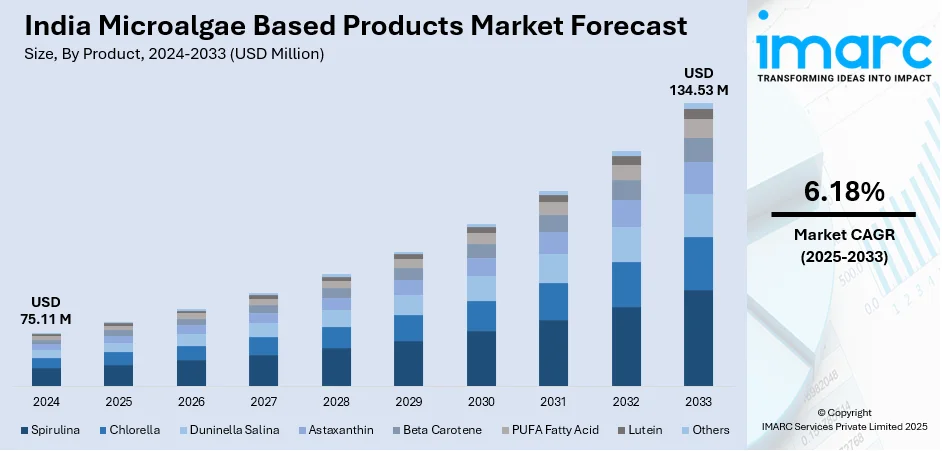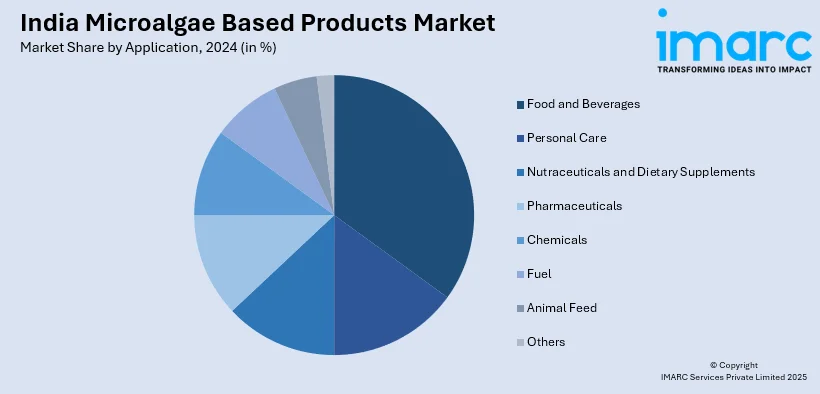
India Microalgae Based Products Market Size, Share, Trends and Forecast by Product, Application, and Region, 2025-2033
India Microalgae Based Products Market Size and Share:
The India microalgae based products market size reached USD 75.11 Million in 2024. Looking forward, IMARC Group expects the market to reach USD 134.53 Million by 2033, exhibiting a growth rate (CAGR) of 6.18% during 2025-2033. The market is expanding due to growing demand for plant-based protein, increasing use in nutraceuticals and functional foods, rising awareness of sustainable food sources, government initiatives supporting algae cultivation, advancements in biotechnology, expanding applications in biofuels and cosmetics, and the rising need for natural pigments and bioactive compounds.
|
Report Attribute
|
Key Statistics
|
|---|---|
|
Base Year
|
2024
|
|
Forecast Years
|
2025-2033
|
|
Historical Years
|
2019-2024
|
| Market Size in 2024 | USD 75.11 Million |
| Market Forecast in 2033 | USD 134.53 Million |
| Market Growth Rate (2025-2033) | 6.18% |
India Microalgae Based Products Market Trends:
Integration of Microalgae in Aquafeed and Livestock Nutrition
Microalgae-based products are gaining traction in aquafeed and livestock nutrition due to their high protein content, omega-3 fatty acids, and bioavailable micronutrients. With India’s growing aquaculture and poultry industries, the demand for sustainable and nutrient-rich feed alternatives is increasing. Microalgae such as Spirulina, Chlorella, and Nannochloropsis are replacing traditional fishmeal and soybean meal, reducing dependence on unsustainable sources. The high digestibility and immunostimulatory properties of microalgae make them valuable in improving animal health, feed efficiency, and disease resistance. Additionally, government initiatives promoting sustainable aquaculture and organic livestock farming are driving the adoption of microalgae-based feed solutions, enhancing India’s food security and environmental sustainability. For instance, in June 2024, CSIR-IICT scientists identified Chlorella Growth Factor (CGF) from Chlorella sorokiniana as a high-quality protein supplement for food and feed applications. Microalgae, being under-exploited, do not compete with traditional crops for space or resources. The study highlights CGF’s superior amino acid profile, positioning it as a sustainable alternative protein source. This research supports India’s growing demand for plant-based proteins, benefiting human nutrition and animal feed industries.

To get more information on this market, Request Sample
Sustainable Product Application
Sustainable product applications drive market trends for microalgae-based products due to increasing environmental concerns, regulatory pressures, and demand for eco-friendly alternatives across industries. Microalgae offer biodegradable, renewable, and carbon-neutral solutions, making them ideal for bioplastics, wastewater treatment, sustainable packaging, biofuels, and natural pigments. Governments and corporations are investing in green technologies, driving research in microalgae-derived bioactive compounds, food supplements, and industrial biomaterials. The growing shift toward circular economy models is further promoting microalgae-based carbon sequestration, bioremediation, and organic agriculture inputs. With advancements in biotechnology and scalable cultivation, microalgae are emerging as cost-effective, high-value alternatives to synthetic ingredients, making sustainability a key driver of innovation and market expansion in the global microalgae-based products industry. For instance, in November 2024, IIT Guwahati researchers developed a sustainable method for ammonium removal from wastewater using microalgae and bacteria. This energy-efficient process eliminates the need for external aeration, reducing energy consumption by 91.33%. The photo-sequencing batch reactor (PSBR) system enables microalgae to produce oxygen, which is used by nitrifying bacteria to convert ammonium into non-toxic byproducts. This breakthrough offers a cost-effective, eco-friendly wastewater treatment solution, addressing pollution from sewage, industrial waste, and agricultural runoff.
India Microalgae Based Products Market Segmentation:
IMARC Group provides an analysis of the key trends in each segment of the market, along with forecasts at the region/country level for 2025-2033. Our report has categorized the market based on product and application.
Product Insights:
- Spirulina
- Chlorella
- Duninella Salina
- Astaxanthin
- Beta Carotene
- PUFA Fatty Acid
- Lutein
- Others
The report has provided a detailed breakup and analysis of the market based on the product. This includes spirulina, chlorella, duninella salina, astaxanthin, beta carotene, PUFA fatty acid, lutein, and others.
Application Insights:

- Food and Beverages
- Personal Care
- Nutraceuticals and Dietary Supplements
- Pharmaceuticals
- Chemicals
- Fuel
- Animal Feed
- Others
A detailed breakup and analysis of the market based on the application have also been provided in the report. This includes food and beverages, personal care, nutraceuticals and dietary supplements, pharmaceuticals, chemicals, fuel, animal feed, and others.
Regional Insights:
- North India
- South India
- East India
- West India
The report has also provided a comprehensive analysis of all the major regional markets, which include North, South, East, and West India.
Competitive Landscape:
The market research report has also provided a comprehensive analysis of the competitive landscape. Competitive analysis such as market structure, key player positioning, top winning strategies, competitive dashboard, and company evaluation quadrant has been covered in the report. Also, detailed profiles of all major companies have been provided.
India Microalgae Based Products Market News:
- In June 2023, Tata Chemicals Limited (TCL) partnered with CSMCRI to produce biodiesel from microalgae. TCL will establish a facility in Mithapur, Gujarat, cultivating Chlorella species in an open marine environment to extract crude oil for automobile fuel. This marks TCL as the first private firm to adopt CSMCRI’s technology, enhancing India’s biofuel sector.
India Microalgae Based Products Market Report Coverage:
| Report Features | Details |
|---|---|
| Base Year of the Analysis | 2024 |
| Historical Period | 2019-2024 |
| Forecast Period | 2025-2033 |
| Units | Million USD |
| Scope of the Report |
Exploration of Historical Trends and Market Outlook, Industry Catalysts and Challenges, Segment-Wise Historical and Future Market Assessment:
|
| Products Covered | Spirulina, Chlorella, Duninella Salina, Astaxanthin, Beta Carotene, PUFA Fatty Acid, Lutein, Others |
| Applications Covered | Food And Beverages, Personal Care, Nutraceuticals and Dietary Supplements, Pharmaceuticals, Chemicals, Fuel, Animal Feed, Others |
| Regions Covered | North India, South India, East India, West India |
| Customization Scope | 10% Free Customization |
| Post-Sale Analyst Support | 10-12 Weeks |
| Delivery Format | PDF and Excel through Email (We can also provide the editable version of the report in PPT/Word format on special request) |
Key Questions Answered in This Report:
- How has the India microalgae based products market performed so far and how will it perform in the coming years?
- What is the breakup of the India microalgae based products market on the basis of product?
- What is the breakup of the India microalgae based products market on the basis of application?
- What are the various stages in the value chain of the India microalgae based products market?
- What are the key driving factors and challenges in the India microalgae based products market?
- What is the structure of the India microalgae based products market and who are the key players?
- What is the degree of competition in the India microalgae based products market?
Key Benefits for Stakeholders:
- IMARC’s industry report offers a comprehensive quantitative analysis of various market segments, historical and current market trends, market forecasts, and dynamics of the India microalgae based products market from 2019-2033.
- The research report provides the latest information on the market drivers, challenges, and opportunities in the India microalgae based products market.
- Porter's Five Forces analysis assist stakeholders in assessing the impact of new entrants, competitive rivalry, supplier power, buyer power, and the threat of substitution. It helps stakeholders to analyze the level of competition within the India microalgae based products industry and its attractiveness.
- Competitive landscape allows stakeholders to understand their competitive environment and provides an insight into the current positions of key players in the market.
Need more help?
- Speak to our experienced analysts for insights on the current market scenarios.
- Include additional segments and countries to customize the report as per your requirement.
- Gain an unparalleled competitive advantage in your domain by understanding how to utilize the report and positively impacting your operations and revenue.
- For further assistance, please connect with our analysts.
 Request Customization
Request Customization
 Speak to an Analyst
Speak to an Analyst
 Request Brochure
Request Brochure
 Inquire Before Buying
Inquire Before Buying




.webp)




.webp)












